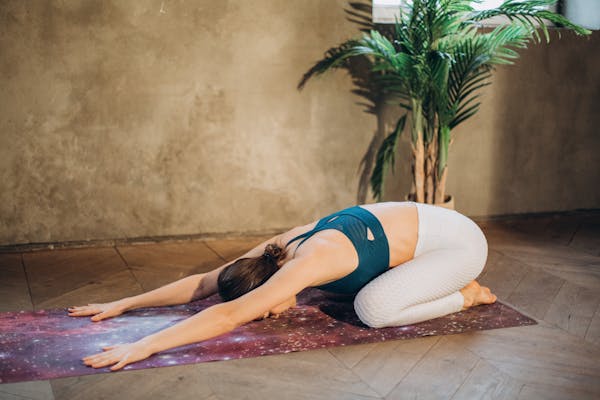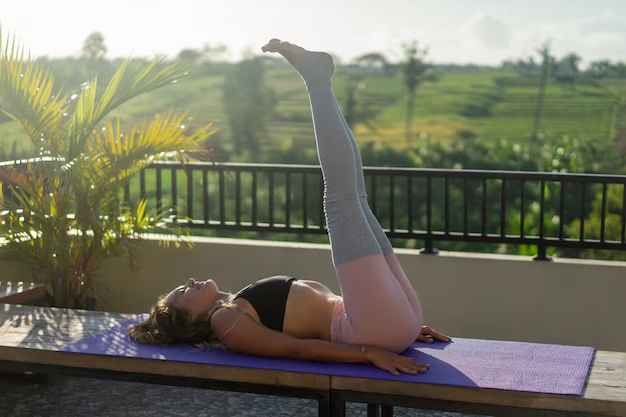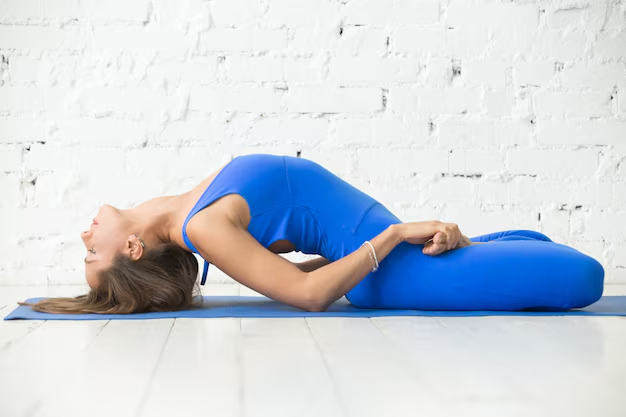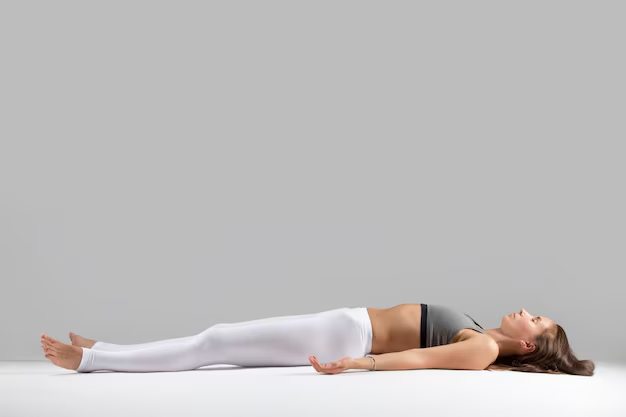Table of Contents
Introduction: The Power of Yoga Sleep
Yoga Sleep The Ultimate Guide to Restful Nights and Energized Mornings Restful and rejuvenating sleep is sometimes out of our reach in today’s fast-paced world. Stress, anxiety, physical discomfort, among others, may hinder a good night’s rest.
Sleep is essential for our well-being-the immune system, mental clarity, and emotional balance-all being affected. In the absence of it, we feel drained, irritable, with the potential for long-term health problems.
Yoga has been used for thousands of years for health, wellness, and inner peace. Recently, yoga and therapy have been acknowledged to be a perfect combination that could improve sleep quality.
Through its physical postures, breathing exercises, and mindfulness practices, yoga relaxes both the body and mind, thereby creating an environment for restorative sleep.
This article will explore how yoga and therapy can improve the quality of sleep, help you enjoy peaceful nights, and lead to energized mornings.
We’ll cover the science behind why yoga helps with sleep, introduce you to specific yoga poses and breathing techniques, and give you a simple routine for bringing yoga into your evening.
The Science of Yoga Sleep
The powerful tools of yoga and therapy are used to get at the root causes of poor sleep. To understand how yoga can change your sleep, we need to look at how yoga works on the nervous system.
Yoga induces relaxation by activating the parasympathetic nervous system, often referred to as the “rest and digest” system.
This is different from the sympathetic nervous system, which is associated with the “fight or flight” response, keeping us alert and on edge.
When we practice yoga, we purposefully slow down the nervous system. This helps reduce heart rates, decrease blood pressure, and reduce stress — all relevant factors that help in quality sleep.
Yoga’s theme of mindfulness also has a much larger role in enhancing sleep. In yoga, we try to quiet our minds, abandon restlessness, and allow us to transition from being hyper-vigilant to being calm and relaxed.
Studies have also demonstrated the effectiveness of combining yoga and therapy in the management of various sleep disorders, including insomnia, sleep apnea, and restless leg syndrome.
Further research has indicated that the physical practices of yoga, including asanas, breathing exercises, and mindfulness, are more helpful for individuals with stress-related sleep disorders.
Adding these practices to one’s daily routine helps to regulate the sleep cycle, increases the depth of sleep, and leads to greater mental clarity and emotional health.
How Yoga Helps Improve Sleep
Yoga promotes sleep improvement by targeting several factors affecting our ability to rest negatively. These factors include physical tension, anxiety, and poor sleep hygiene. Let’s dive deeper into the specific ways yoga enhances sleep.
Relaxation and Stress Reduction
There is much evidence showing that stress leads to poor sleep. Stress induces the body to release cortisol, a hormone that prepares us for a fight-or-flight response. High levels of cortisol can lead to sleeplessness or difficulty falling asleep. Lowering cortisol levels is one way that yoga helps reduce stress.
Yoga, through breathing exercises and relaxation techniques, signals the body to relax. Techniques such as deep abdominal breathing or alternate nostril breathing (Nadi Shodhana) activate the parasympathetic nervous system, which leads to a state of calmness and tranquility.
Through the practice of these techniques, people can train their bodies to relax naturally, which makes it easier to fall asleep at night.
Mindfulness and Mental Clarity
These factors that mostly bring sleep deprivation are mental clutter, racing thoughts, and emotional distress.
Our brains will be cluttered and so preoccupied making it difficult for us to get any kind of sleep; also we can be concerned with worrisome thinking. Yoga, like therapy, assists in attaining mindfulness or staying in the moment without judgments toward our own thoughts and emotions.
Mindfulness meditation, practiced in many yoga classes, is a method of quieting the mental chatter that usually keeps us awake.
Scanning of the body or guided imagery increases the clarity of one’s mind so that the person becomes unattached to their stressors and focuses on the present. Adding mindfulness to your nightly routine will help you significantly improve the quality of your sleep and settle down more comfortably.
Physical discomfort, such as tension in the neck, back, or shoulders, can make it difficult to fall asleep. Poor posture throughout the day can also contribute to sleep disturbances. Yoga helps by aligning the body, releasing muscular tension, and promoting a sense of physical ease.
Gentle, restorative poses help open the hips, stretch the back, and release tight muscles. Asanas like the Child’s Pose, Legs-Up-the-Wall Pose, and Reclining Bound Angle Pose focus on gentle stretching, allowing the body to relax and prepare for sleep.
Improving physical comfort through yoga makes it easier to slip into restful sleep without the distraction of discomfort or pain.
Yoga Poses for Better Sleep
You can simply incorporate yoga in your pre-sleep routine as a simple way to improve sleep. Here are a few of the best yoga poses to relax and prepare the body for sleep.
1. Child’s Pose (Balasana)
Child’s Pose is a restorative pose, gentle on the back, neck, and shoulders. It helps to release all the tension in the body, especially in the back, neck, and shoulders, and creates a sense of inner calm.
Begin by getting down on your knees, then slowly lower your torso down toward the ground, bringing your forehead to the floor. Stretch your arms out in front of you or keep them by your sides.
This pose encourages relaxation by lengthening the spine and stretching the hips. It also helps calm the nervous system, making it an ideal pose for before bedtime.

2. Legs-Up-the-Wall Pose (Viparita Karani)
This pose is very calming and is one of the common ones used in yoga therapy for sleep. Lie down on your back with your legs extended upwards a wall. Keep a folded blanket or pillow underneath your hips so that your lower back could just relax, then keep your arms extended along the floor with your palms up.
Legs-Up-the-Wall Pose reverses blood flow, so inflammation and swelling in the lower extremities will be minimized. It is also excellent for calming the mind, so it makes for a perfect resting pose before sleep.

3. Reclined Bound Angle Pose (Supta Baddha Konasana)
It really helps open up the hips so the body can release and open up. First, lie down on your back, bringing knees into your chest.
Your feet need to touch and let your knees fall to each side in such a way that your legs resemble a diamond shape. Let your hands fall either on your tummy or down at your sides.
Reclining Bound Angle Pose encourages deep relaxation and provides a gentle stretch for the inner thighs and hips. It also helps release tension in the lower back and pelvis, which can improve sleep quality.

4. Savasana (Corpse Pose)
Savasana is often referred to as the most important pose in yoga since it allows for total relaxation. Lie flat on your back with your arms at your sides, palms facing upwards. Let go of all remaining tension in the body while focusing on the breath.
This pose helps to integrate the benefits of the previous yoga practice and calms the mind. It is usually used at the end of a yoga session to promote deep relaxation and prepare for a peaceful night’s sleep.

Breathing Techniques to Enhance Sleep
In addition to yoga postures, specific breathing techniques can enhance your sleep. Breathing exercises activate the parasympathetic nervous system, which helps the body relax and prepares it for rest. Below are some breathing techniques that are effective for improving sleep.
1. Nadi Shodhana (Alternate Nostril Breathing)
Nadi Shodhana is a breathing technique that involves inhaling and exhaling through alternate nostrils. This technique helps balance the body’s energy and calm the nervous system, promoting relaxation.
To practice this technique, sit comfortably with your spine straight. Using your right thumb, close your right nostril and inhale through the left. Then close the left nostril and exhale through the right. Continue alternating nostrils for several minutes.
This is a very effective technique to calm the mind and prepare the body for restful sleep.
2. 4-7-8 Breathing
4-7-8 breathing is the easiest technique of relaxing and falling asleep. It can be achieved as follows: Inhale for a count of four through the nose, hold the breath for a count of seven, and then exhale for a count of eight through the mouth. Repeat this cycle up to three or four times before bed.
The 4-7-8 technique helps reduce anxiety and calm the mind, making it easier to drift off to sleep.
3. Diaphragmatic Breathing
Diaphragmatic breathing, also known as belly breathing, helps activate the body’s relaxation response. To practice this technique, place one hand on your chest and the other on your belly. Inhale deeply through your nose, allowing your belly to rise.
Exhale slowly through your mouth, allowing the belly to fall. This breathing technique helps reduce heart rate and lower stress, promoting relaxation and better sleep.
Creating a Sleep-Friendly Yoga Routine
To experience all the benefits of yoga for sleep, consistency is essential. It helps signal to your body that it’s time to wind down and prepare for rest by having a nightly yoga routine. Here’s a simple yet effective routine to follow every night:
Begin with a Relaxing Breathwork Session
Begin by using your breath. Practice Nadi Shodhana or 4-7-8 breathing for 5-10 minutes to calm your mind and reduce stress.
Gentle Yoga Poses
Move into the yoga poses listed above: Child’s Pose, Legs-Up-the-Wall, and Reclining Bound Angle Pose. Spend 3-5 minutes in each pose, focusing on relaxation.
Savasana
Finish your practice by lying in Savasana for 5-10 minutes. Focus on your breath and allow your body to fully relax.
This simple yoga routine, when practiced regularly, can improve the quality of your sleep in a big way.
Yoga and Sleep: A Lifestyle Approach
Yoga and therapy are not quick fixes for sleeplessness; they are long-term solutions. If you do yoga regularly, you will see that the improvement in sleep quality, emotional balance, and physical health is sustainable.
Moreover, mindfulness can be incorporated into your daily life to help manage stress, reduce anxiety, and get more in touch with your body’s natural rhythms.
It’s one step toward a holistic improvement in sleep and health to create a yoga sleep routine. Combine it with some proper sleep hygiene, such as cutting down on screen time before bed, making your sleep environment relaxing, and waking up and sleeping at the same time every night, and this will amplify your benefits.
Conclusion: Unlock Restful Sleep with Yoga
One of the most effective ways to achieve restful nights and energized mornings is by incorporating yoga and therapy into your nightly routine.
Yoga helps ease tension, calm the mind, and improve overall sleep quality by combining physical postures, mindful breathing, and relaxation techniques. Whether you are dealing with insomnia, anxiety, or simply seeking to improve the quality of your rest, yoga offers a natural and holistic approach to sleep wellness.
Remember, yoga and therapy are powerful tools that can transform your sleep patterns. Practice consistently, and you’ll soon be enjoying the restorative sleep your body and mind deserve.
